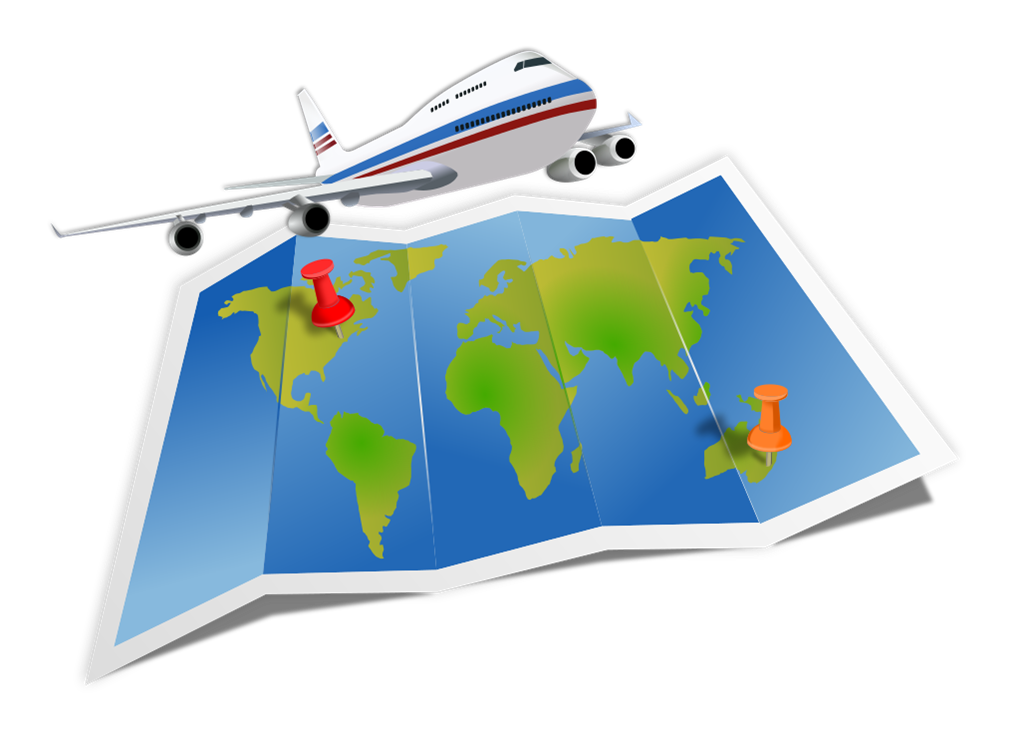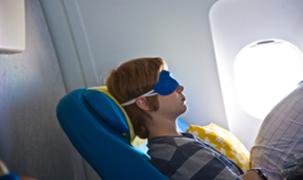|
How to manage jet lag - "What helps me sleep is having a bedtime ritual. Stop using electronics one hour before bedtime, have a cup of tea, and read a bit. Usually that does the trick, but if I can't sleep after an hour I just get up, do something else, and then try again."
"While most passengers tend to choose seats that are at the front of the aircraft so that they can disembark first and have a better chance of securing their preferred meal option, flight attendants know that if you're sitting towards the back, you'll receive the most attentive service." |
Sleeping on Planes....
Not enough legroom. People climbing over you. Noise from movies and video games and screaming children. Sunlight pouring in your neighbor's window at 35,000 feet. With all the distractions and hassles of air travel, what doesn't make it tough to sleep on planes?
If you struggle to get some shuteye each time you take to the air, you're not alone -- but choosing the right seat, bringing the right gear and making a few small changes in your flying habits could help you sleep better on your next flight. Read on for our travel-tested tips.
Choose your seat wisely.
Your seat location could be one of the most important factors in how well -- or how poorly -- you sleep on your next trip. Try to get a window seat if possible; it will give you something to lean against and get you out of the way of other folks in your row, who won't have to scramble over you each time they need to use the bathroom. You'll also have some control over the window shade.
Think twice about bulkhead or exit row seats. Sure, the extra legroom is great, but some exit row seats do not recline (so that they won't be an obstruction in case of emergency), and some bulkhead seats have armrests that can't be raised. Sleeping in one of these is like sleeping in a straitjacket, especially if the seat next to you is unoccupied, or worse, the entire row is empty (as happened to me on a flight from Australia -- 14 hours in the air, an empty row and the worst flight I've ever had). What could have been a nice sleep nook is now more like, well, an airplane seat.
Andrea Rotondo of LuxuryCruiseBible.com also cautions against bulkhead seats because they "are often reserved for families traveling with babies or young kids, [and] can be noisy."
Another area to avoid is the last row of the plane. Again, the seats may not recline, and they're often located right near the lavatories -- where both noise and odor could be an issue.
Aside from the very last row, there are pros and cons to sitting near the front of the plane and sitting near the back. Seats near the rear of the plane may be noisier due to the planes' engines and clink-clanking from the galley, but it's also more likely that you'll have a couple of seats (or even a whole row) to yourself back there -- and the extra space could make up for the extra noise.
To help you choose your seat, check out SeatGuru.com, which offers color-coded seating charts for nearly every plane on every airline. And don't miss our tips for getting the best airplane seat.
Cut down on your carry-ons.
If you have two full-size carry-ons, one might end up under your feet, limiting your legroom and making it harder to sleep. Instead, pack lighter so you can fit everything into a single bag. Keep a few small necessities near the top of the bag -- a book or magazine, a snack, a bottle of water. Before you stow your bag in the overhead compartment, pull out the important items that you'll need during the flight and put them in the back of the seat in front of you.
Editor's Note: The Federal Aviation Administration (FAA) cautions against the stowage of personal items in the seatback pocket for safety reasons, but states, "If small, lightweight items, such as eyeglasses or a cell phone, can be placed in the seat pocket without exceeding the total designed weight limitation of the seat pocket or so that the seat pocket does not block anyone from evacuating the row of seats, it may be safe to do so." Keep the items you stow in the seatback pocket to a minimum, and be aware that flight attendants may ask you to put the items back into your carry-on bag.
If you struggle to get some shuteye each time you take to the air, you're not alone -- but choosing the right seat, bringing the right gear and making a few small changes in your flying habits could help you sleep better on your next flight. Read on for our travel-tested tips.
Choose your seat wisely.
Your seat location could be one of the most important factors in how well -- or how poorly -- you sleep on your next trip. Try to get a window seat if possible; it will give you something to lean against and get you out of the way of other folks in your row, who won't have to scramble over you each time they need to use the bathroom. You'll also have some control over the window shade.
Think twice about bulkhead or exit row seats. Sure, the extra legroom is great, but some exit row seats do not recline (so that they won't be an obstruction in case of emergency), and some bulkhead seats have armrests that can't be raised. Sleeping in one of these is like sleeping in a straitjacket, especially if the seat next to you is unoccupied, or worse, the entire row is empty (as happened to me on a flight from Australia -- 14 hours in the air, an empty row and the worst flight I've ever had). What could have been a nice sleep nook is now more like, well, an airplane seat.
Andrea Rotondo of LuxuryCruiseBible.com also cautions against bulkhead seats because they "are often reserved for families traveling with babies or young kids, [and] can be noisy."
Another area to avoid is the last row of the plane. Again, the seats may not recline, and they're often located right near the lavatories -- where both noise and odor could be an issue.
Aside from the very last row, there are pros and cons to sitting near the front of the plane and sitting near the back. Seats near the rear of the plane may be noisier due to the planes' engines and clink-clanking from the galley, but it's also more likely that you'll have a couple of seats (or even a whole row) to yourself back there -- and the extra space could make up for the extra noise.
To help you choose your seat, check out SeatGuru.com, which offers color-coded seating charts for nearly every plane on every airline. And don't miss our tips for getting the best airplane seat.
Cut down on your carry-ons.
If you have two full-size carry-ons, one might end up under your feet, limiting your legroom and making it harder to sleep. Instead, pack lighter so you can fit everything into a single bag. Keep a few small necessities near the top of the bag -- a book or magazine, a snack, a bottle of water. Before you stow your bag in the overhead compartment, pull out the important items that you'll need during the flight and put them in the back of the seat in front of you.
Editor's Note: The Federal Aviation Administration (FAA) cautions against the stowage of personal items in the seatback pocket for safety reasons, but states, "If small, lightweight items, such as eyeglasses or a cell phone, can be placed in the seat pocket without exceeding the total designed weight limitation of the seat pocket or so that the seat pocket does not block anyone from evacuating the row of seats, it may be safe to do so." Keep the items you stow in the seatback pocket to a minimum, and be aware that flight attendants may ask you to put the items back into your carry-on bag.
In the Air....
Here is some information that will help to make your journey as comfortable as possible.
We also recommend that you:
Any special requirements should be mentioned at the time of booking to ensure that your special needs can be accommodated during your flight.
- Drink plenty of fluids: water, juice or non-caffeinated soft drinks to prevent dehydration, fatigue and headaches. Minimise intake of alcohol and coffee.
- Moisten the face to help reduce the drying effects of cabin air.
- Eat lightly
- Exercise and stretch regularly by doing gentle on board exercises for about five minutes every one to two hours. Exercises can include ankle circles, foot pumps, knee lifts, shoulder rolls and arm curls.
We also recommend that you:
- don't cross your legs
- occasionally walk down the aisle
- gently bend your neck down towards each shoulder
- move your shoulders upward, then lower slowly
- wiggle your toes and then raise one foot at a time
- exercise your calf muscles while seated by regularly flexing and rotating ankles for a few minutes
Any special requirements should be mentioned at the time of booking to ensure that your special needs can be accommodated during your flight.



